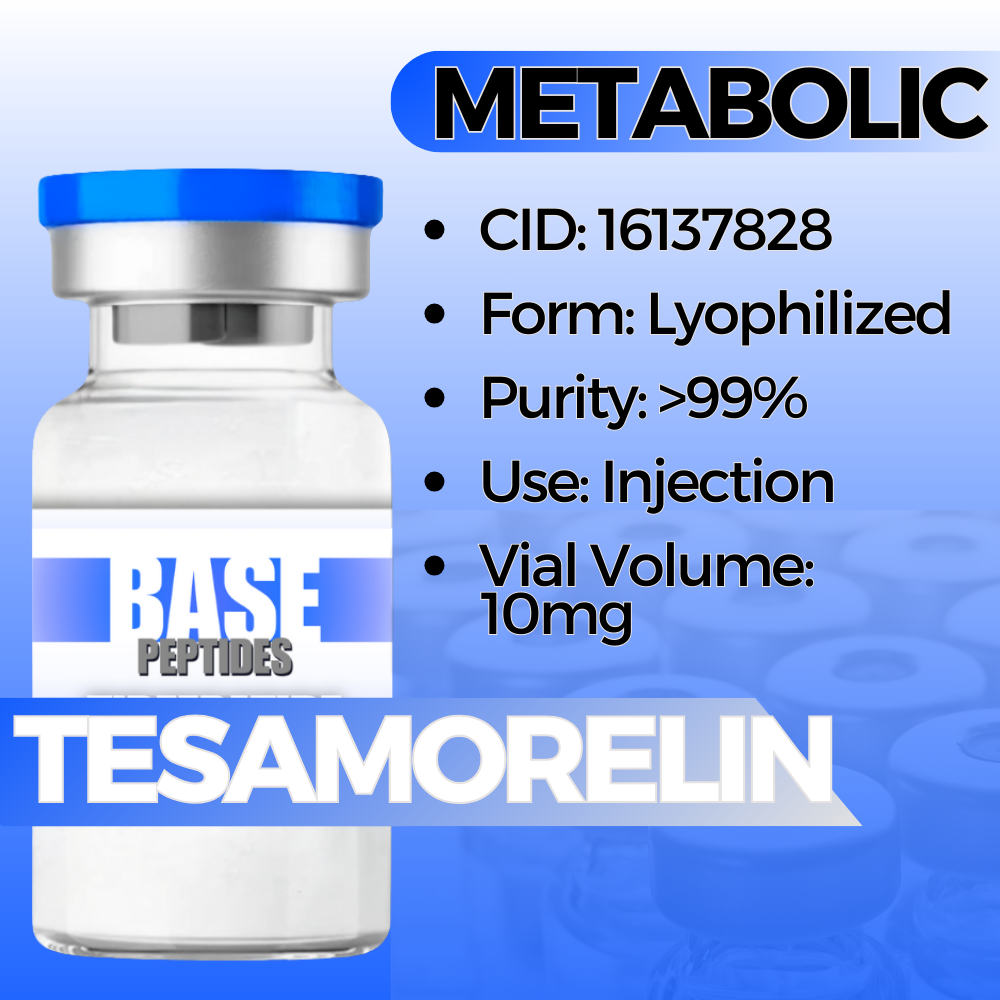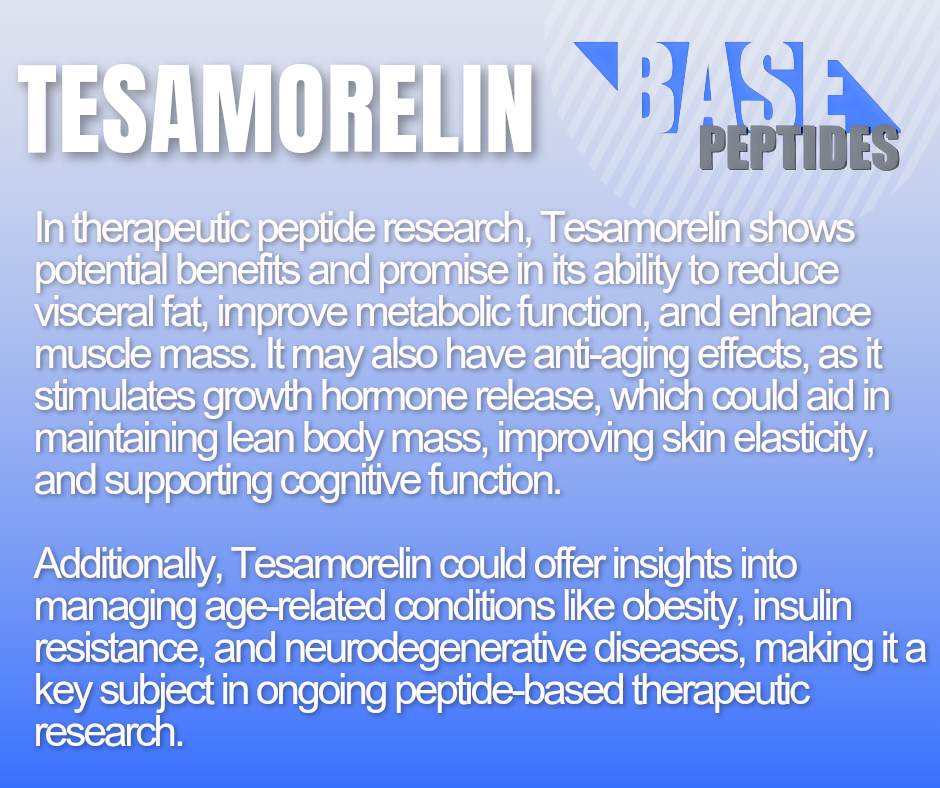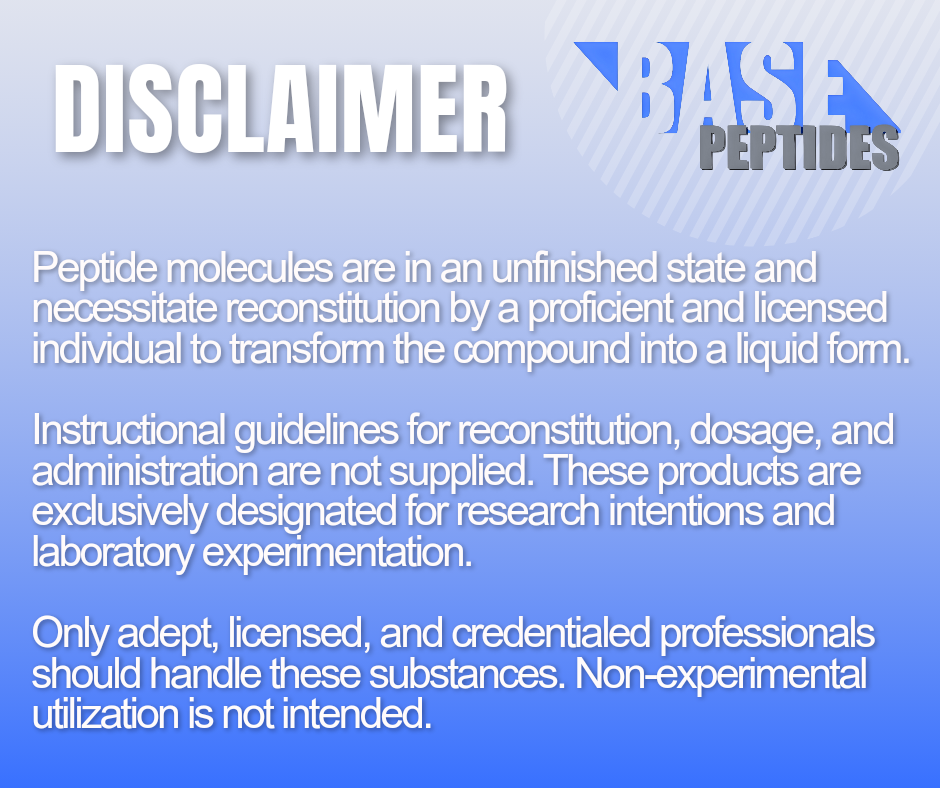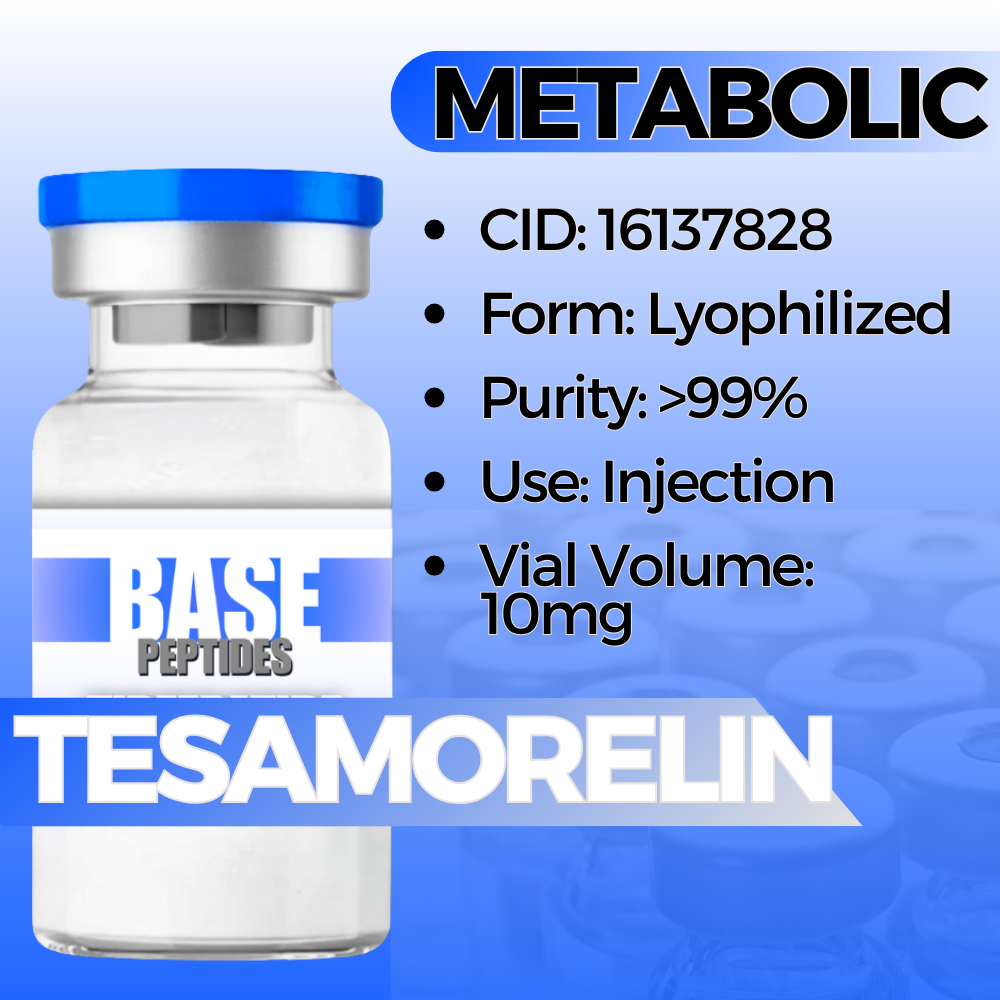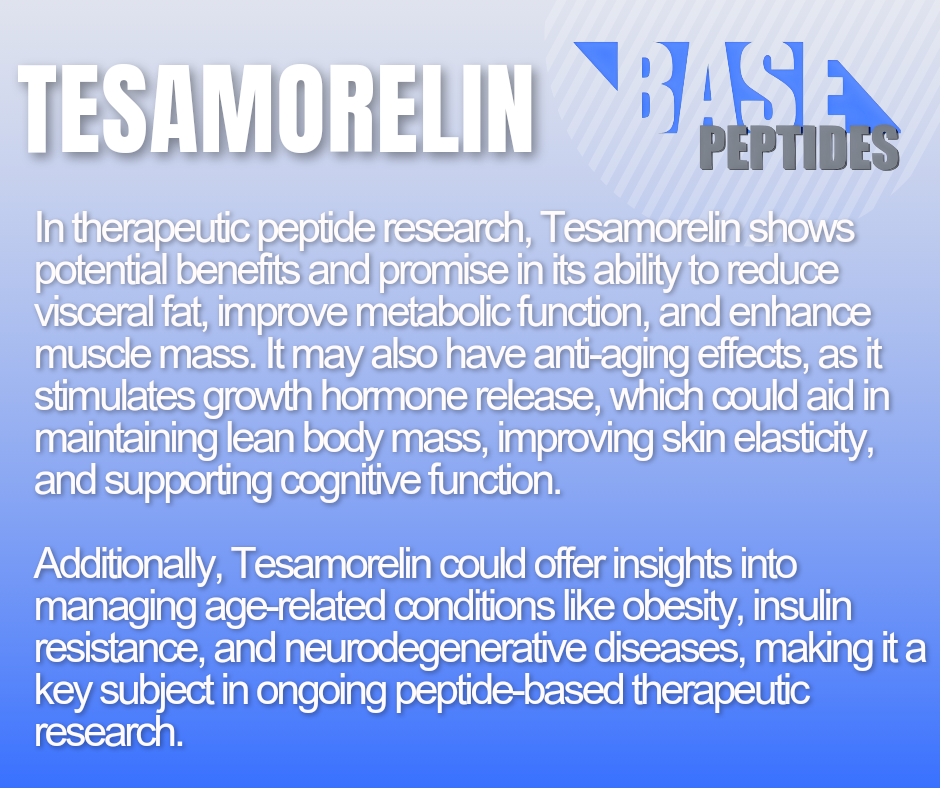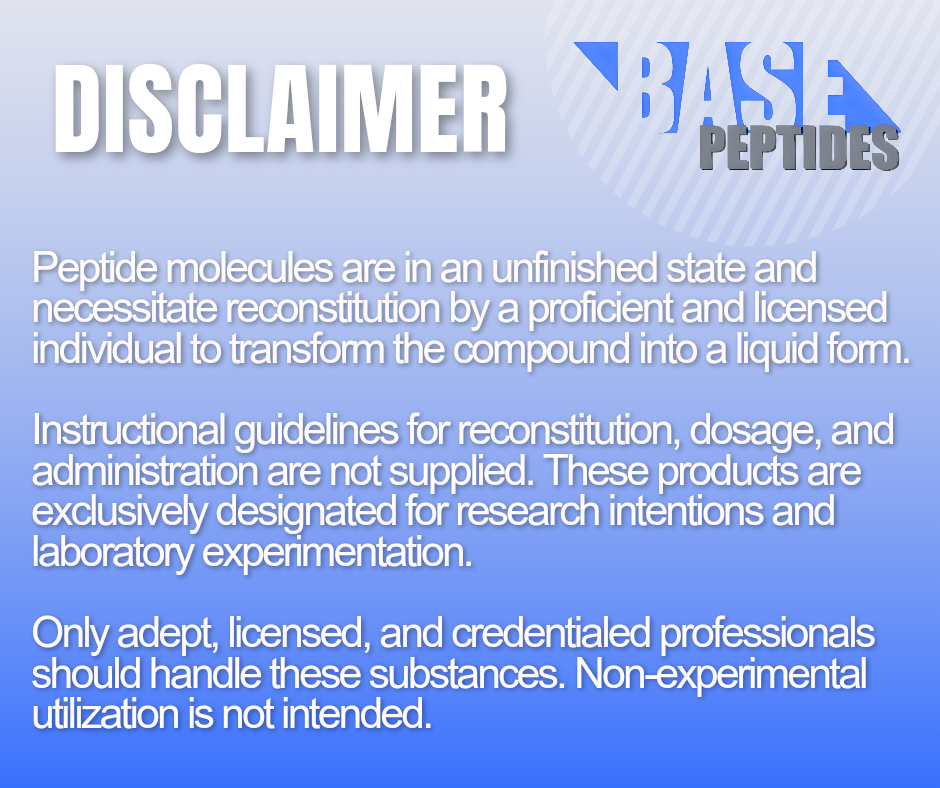Tesamorelin
Tesamorelin
Base Peptides are intended for licensed medical professionals and experienced researchers. Reconstitution required. Dosing and use instructions are not provided.
Couldn't load pickup availability
Tesamorelin — Research-Grade GHRH Analogue
Tesamorelin is a stabilized version of the body’s own GHRH signal. In research, it’s used to nudge the growth-hormone (GH) system to work naturally—so labs can study changes in IGF-1, visceral fat (VAT), liver fat, and metabolic markers without using direct GH.
- CAS: 218949-48-5
- PubChem CID: 146681838
- Formula / MW: C221H366N72O67S · ~5,135.8 Da
- Sequence: GHRH(1-44) analogue with an N-terminal stabilization (trans-3-hexenoic acid)
- Tesamorelin binds the same receptor your natural GHRH uses.
- That signals the pituitary to release GH in a physiologic, pulse-like way.
- GH then raises IGF-1, which is tied to how the body handles fat and lean tissue.
- To study visceral fat (VAT) changes measured by CT or MRI.
- To observe liver fat changes with MR-spectroscopy.
- To map GH → IGF-1 signaling without giving GH directly.
Key Studies — What Was Tested, What Changed, Why It Matters
Two large randomized trials in people with HIV on ART (excess VAT)
- Design, in brief: Daily 2 mg tesamorelin vs placebo for 26 weeks; some continued to 52 weeks.
- What changed: About a 15% drop in visceral fat vs placebo at 26 weeks. Those who continued generally kept the benefit at 52 weeks. Subcutaneous fat was mostly preserved.
- Why it matters: Tesamorelin helps researchers isolate visceral fat changes—important because VAT is more strongly linked to metabolic risk than the fat under the skin.
- Context signals tracked: IGF-1, triglycerides, and glucose markers for a fuller metabolic picture.
VAT + Liver fat (6-month double-blind study with imaging)
- Design, in brief: Randomized, placebo-controlled, 6 months.
- What changed: Significant VAT reduction and a modest decrease in liver fat (measured by MR-spectroscopy).
- Why it matters: Supports the idea that restoring a healthier GH/IGF-1 rhythm can favor how and where the body stores fat—especially in the liver.
Who tends to respond better? (predictor analysis)
- Design, in brief: Post-study analysis of the big trials.
- Signal: People with higher starting VAT or features of metabolic syndrome often showed larger VAT improvements.
- Why it matters: Helps labs pre-define responder groups and stratify subjects up front.
Potential Research Applications
Metabolic & Adipose Biology
- CT/MRI VAT quantification
- Triglycerides, adipokines, inflammation panels
Liver & Ectopic Fat
- MR-spectroscopy liver fat fraction
- Protocol-dependent NAFLD-style models
GH/IGF-1 Axis Mapping
- IGF-1 kinetics, binding proteins, pulse analysis
- Downstream signaling and tissue markers
Synergistic Peptides (for Study Design)
CJC-1295 (with DAC)
- What it is: A long-acting GHRH analogue (prolonged effect).
- Why pair it: Useful in duration or frequency studies comparing short- vs long-acting GHRH-style signals.
- Typical research angle: IGF-1 exposure over time, pulse patterns, and body-composition markers.
Ipamorelin (GHSR agonist)
- What it is: A selective ghrelin-receptor (GHSR) agonist—a different upstream switch for GH.
- Why pair it: Lets labs explore dual-pathway stimulation (GHRH + GHSR) vs either alone.
- Typical research angle: Additive or complementary GH release, IGF-1 response, and downstream markers.
Sermorelin / Mod GRF (1-29)
- What it is: Short-acting GHRH-type analogues.
- Why pair it: Good for timing experiments (short pulses) or as a comparator to longer-acting analogues like Tesamorelin or CJC-1295.
- Typical research angle: Pulse frequency vs amplitude studies; receptor sensitivity.
Design Notes
- Keep groups clearly separated (GHRH-only vs GHSR-only vs combo).
- Pre-define endpoints: IGF-1 time-course, VAT change on imaging, lipid/glucose panels.
- Document timing relative to sampling to interpret pulses accurately.
Known Concerns (Context)
- Glucose: Some studies note small, temporary rises in fasting glucose—track per protocol.
- Common observations: Injection-site reactions, mild joint swelling, or fluid retention have been reported in labeled contexts.
- Program scope: Tesamorelin isn’t a general weight-loss agent; it’s best suited to VAT-focused and mechanistic research questions.
Follow your institution’s SOPs and oversight (IRB/IBC) for handling and design.
Specifications & Handling
- Form: Lyophilized powder (lot-coded)
- Purity: ≥ 99% (HPLC/MS; lot-verified)
- Storage: ≤ −20 °C; protect from light and moisture
- In solution: Aliquot promptly; avoid repeat freeze–thaw
- Additives: None unless specified on the lot
- Packaging: Tamper-evident; research-only labeling
Regulatory & Use Notice
Sold for laboratory research use only. Not for human consumption, medical, or veterinary use. No human-use instructions are provided. Buyer is responsible for safe handling and regulatory compliance.
Tesamorelin Peptide Research | GHRH Analogue | Visceral Fat (VAT), Liver Fat & IGF-1 Studies
